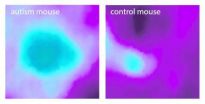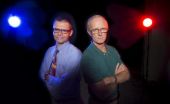(Press-News.org) In what is believed to be the largest genetic analysis of what triggers and propels progression of tumor growth in a common childhood blood cancer, researchers at NYU Langone Medical Center report that they have identified a possible new drug target for treating the disease.
T-cell acute lymphoblastic leukemia is one of the most common and aggressive childhood blood cancers. An estimated quarter of the 500 adolescents and young adults diagnosed with the cancer each year in the U.S. fail to achieve remission with standard chemotherapy drugs.
In a cover-story report set to appear in the journal Cell online July 31, the NYU Langone team describes how they used advanced genetic scanning techniques to identify 6,023 so-called long, non-coding strands of RNA, vital chemical cousins of DNA, that were active in the immune system T cells taken from 15 boys and girls with T-cell acute lymphoblastic leukemia, but not active in the healthy T cells in three young people without the disease.
Further analysis found that chemically blocking the action of one of those non-protein-producing RNAs, known as leukemia-induced non-coding activator RNA-1, or LUNAR1 for short, stalled leukemia progression.
Study investigators say LUNAR1 was not singled out from RNA typically used by DNA to make proteins, but rather from among the most prevalent RNA — long chemical strands of translated DNA, previously termed "junk DNA" — which can help transcribe DNA but never fully assemble proteins. They say these long non-coding RNAs are increasingly recognized as key to regulating many cell functions.
Senior study investigator and NYU Langone cancer biologist Iannis Aifantis, PhD, says the study offers preliminary evidence that drugs blocking LUNAR1 could treat T-cell acute lymphoblastic leukemia and a long-sought alternative to chemotherapeutic drugs that kill both cancer and normal cells.
Aifantis, a professor and chair of pathology at the Laura and Isaac Perlmutter Cancer Center at NYU Langone, and an early career scientist at the Howard Hughes Medical Institute, also says LUNAR1 could aid in diagnosing the blood cancer.
"Our study shows that LUNAR1 is highly specific for T-cell acute lymphoblastic leukemia and plays a key role in how this cancer develops," he says, pointing out that overproduction of LUNAR1 was recorded in almost all (90 percent) of leukemia patients tested.
Moreover, Aifantis says, his team's latest findings suggest that development of future cancer therapies based on the underlying genetics of each patient should involve "not just mutations in someone's DNA, but also alterations in the makeup of RNA."
Among the study's other key findings was that while LUNAR1 does not produce cancerous proteins on its own, its production was essential to the cell-to-cell signaling action of another protein, insulin-like growth factor 1 receptor (IGF-1R), already tied to many cancers, including leukemia.
Further laboratory experiments showed that the gene coding for LUNAR1 is near the gene for IGF-1R and located toward the chromosomes' ends, known as telomeres. When activated, LUNAR1's position allows it to chemically loop back and, in turn, bind to and activate IGF-1R.
Researchers zeroed in on LUNAR1 by pinpointing those RNAs that also were active in the NOTCH1 biological pathway. They say the NOTCH1 pathway is common to many cancers, but is especially active in at least half of all people with T-cell acute lymphoblastic leukemia. LUNAR1 stood out right away, they say, as the most highly expressed long, non-coding RNA, of which more than half were newly discovered.
According to Aifantis, his team's research shows that T-cell acute lymphoblastic leukemia, as is the case in many other cancers, could be simply described as a condition of "too much errant signaling." He says in normal T cells, the long, non-coding RNAs such as LUNAR1 are not transcribed, NOTCH1 is inactive, and there is no looping back of LUNAR1 to activate IGF-1R.
To confirm their findings, researchers also transplanted human leukemia T cells into mice to prompt tumor growth, and chemically blocked LUNAR1 in some of the animals. Tumor growth stalled only in those mice whose LUNAR1 was inactivated.
Aifantis says his team's next steps are to develop more effective inhibitors of LUNAR1, preferably something that would precisely target any one or more of its 200-plus component nucleotides.
INFORMATION:
Funding support for the study was provided by the U.S. National Cancer Institute and National Institute of General Medical Sciences, both parts of the National Institutes of Health. Corresponding federal grant numbers are P30 CA016087-30, R01 CA133379, R01 CA149655, R01 CA173636, R01 169784, R01 GM088847, and T32-CA009161-37. Further funding support was provided by the William Lawrence and Blanche Hughes Foundation; the Leukemia and Lymphoma Society (corresponding grant numbers TRP#6340 -11 and LLS#6373-13), the Chemotherapy Foundation, the Irma T. Hirschl Trust, the V Foundation for Cancer Research, and the St. Baldrick's Foundation.
Besides Aifantis, other NYU Langone researchers involved in these experiments were lead study investigator Thomas Trimarchi, BSc, and study co-investigators Panagiotis Ntziachristos, PhD, and Aristotelis Tsirigos, PhD. Additional research support was provided by Erhan Bilal, PhD, at the IBM Thomas J. Watson Research Center; and Giulia Fabbri, PhD, and Riccardo Dalla-Favera, MD, at Columbia University in New York.
For more information, go to:
http://www.aifantislab.com/
http://www.cell.com/cell/home
About NYU Langone Medical Center:
NYU Langone Medical Center, a world-class, patient-centered, integrated academic medical center, is one of the nation's premier centers for excellence in clinical care, biomedical research, and medical education. Located in the heart of Manhattan, NYU Langone is composed of four hospitals — Tisch Hospital, its flagship acute care facility; Rusk Rehabilitation; the Hospital for Joint Diseases, the Medical Center's dedicated inpatient orthopaedic hospital; and Hassenfeld Children's Hospital, a comprehensive pediatric hospital supporting a full array of children's health services across the Medical Center — plus the NYU School of Medicine, which since 1841 has trained thousands of physicians and scientists who have helped to shape the course of medical history. The Medical Center's tri-fold mission to serve, teach, and discover is achieved 365 days a year through the seamless integration of a culture devoted to excellence in patient care, education, and research. For more information, go to http://www.NYULMC.org, and interact with us on Facebook, Twitter, and YouTube.
Media Inquiries:
David March
212 .404.3528│david.march@nyumc.org
Drug target identified for common childhood blood cancer
LUNAR1-inhibiting drugs hold potential as first alternative to standard chemotherapy
2014-07-31
ELSE PRESS RELEASES FROM THIS DATE:
Molecule enhances copper's lethal punch against microbes
2014-07-31
DURHAM, N.C. – Harnessing a natural process in the body that pumps lethal doses of copper to fungi and bacteria shows promise as a new way to kill infectious microbes, a team of scientists at Duke University report.
Publishing in the July 31, 2014, issue of the journal Chemistry & Biology, the researchers describe a way of exploiting the unique chemical response from the body's immune system to attack pathogens using copper, long known for its antimicrobial properties, in a way that minimizes harm to the rest of the body.
The findings in cell and animal models represent ...
Master HSF supports reprogramming of normal cells to enable tumor growth and metastasi
2014-07-31
CAMBRIDGE, Mass. (July 31, 2014) – Long associated with enabling the proliferation of cancer cells, the ancient cellular survival response regulated by Heat-Shock Factor 1 (HSF1) can also turn neighboring cells in their environment into co-conspirators that support malignant progression and metastasis.
The finding, reported by Whitehead Institute scientists this week in the journal Cell, lends new insights into tumor biology with significant implications for the diagnosis, prognosis, and management of cancer patients.
Over the past several years, researchers in the ...
Insular cortex alterations in mouse models of autism
2014-07-31
This news release is available in German.
The insular cortex is an integral "hub", combining sensory, emotional and cognitive content. Not surprisingly, alterations in insular structure and function have been reported in many psychiatric disorders, such as anxiety disorders, depression, addiction and autism spectrum disorders (ASD). Scientists from Harvard University and the Max-Planck Institute of Neurobiology in Martinsried now describe consistent alterations in integrative processing of the insular cortex across autism mouse models of diverse etiologies. In particular, ...
C. difficile vaccine proves safe, 100 percent effective in animal models
2014-07-31
An experimental vaccine protected 100 percent of animal models against the highly infectious and virulent bacterium, Clostridium difficile, which causes an intestinal disease that kills approximately 30,000 Americans annually. The research is published ahead of print in Infection and Immunity.
In the study, the vaccine protected the mice and non-human primates against the purified toxins produced by C. difficile, as well as from an orogastric spore infection, a laboratory model that mimics the human disease, after only two immunizations.
"Animals that received two ...
Scientists find growing consensus: Political attitudes derive from body and mind
2014-07-31
Lincoln, Neb., July 31, 2014 -- Do people make a rational choice to be liberal or conservative? Do their mothers raise them that way? Is it a matter of genetics?
Two political scientists from the University of Nebraska-Lincoln and a colleague from Rice University say that neither conscious decision-making nor parental upbringing fully explain why some people lean left while others lean right.
A growing body of evidence shows that physiological responses and deep-seated psychology are at the core of political differences, the researchers say in the latest issue of the ...
Strict genomic partitioning by biological clock separates key metabolic functions
2014-07-31
Irvine, Calif., July 31, 2014 — Much of the liver's metabolic function is governed by circadian rhythms – our own body clock – and UC Irvine researchers have now found two independent mechanisms by which this occurs.
The study, published online today in Cell, reveals new information about the body clock's sway over metabolism and points the way to more focused drug treatments for liver disease and such metabolic disorders as obesity and diabetes.
Paolo Sassone-Corsi, UCI's Donald Bren Professor of Biological Chemistry, and postdoctoral scholar Selma Masri report that ...
Simple tips to fend off freak-outs
2014-07-31
There's sad news in the study of happiness.
Rest assured, there is a happy ending, though.
University of Cincinnati research on perceived happiness shows that many college students are stressed out and aren't coping.
This is despite the fact that there are simple ways for students to relieve stress and feel happier, says Keith King, professor and coordinator of UC's Health Promotion and Education Program. The trouble is, they don't use them enough.
"We have a whole array of different stress-management techniques college students can use and that we teach, but they're ...
New report calls for strong, positive safety culture in academic chemical labs
2014-07-31
WASHINGTON -- Everyone involved in the academic chemical research enterprise -- from researchers and principal investigators to university leadership -- has an important role to play in establishing and promoting a strong, positive safety culture, says a new report from the National Research Council. This requires a constant commitment to safety organization-wide and emphasis on identifying and solving problems, rather than merely adhering to a set of rules and assigning blame when those rules are not followed.
Chemical hazards can be found in many academic fields ...
Spin diagnostics
2014-07-31
Magnetic resonance imaging (MRI), which is the medical application of nuclear magnetic resonance spectroscopy, is a powerful diagnostic tool. MRI works by resonantly exciting hydrogen atoms and measuring the relaxation time -- different materials return to equilibrium at different rates; this is how contrast develops (i.e. between soft and hard tissue). By comparing the measurements to a known spectrum of relaxation times, medical professionals can determine whether the imaged tissue is muscle, bone, or even a cancerous growth. At its heart, MRI operates by quantum principles, ...
Pressure probing potential photoelectronic manufacturing compound
2014-07-31
Washington, D.C.— Molybdenum disulfide is a compound often used in dry lubricants and in petroleum refining. Its semiconducting ability and similarity to the carbon-based graphene makes molybdenum disulfide of interest to scientists as a possible candidate for use in the manufacture of electronics, particularly photoelectronics.
New work from a team including several Carnegie scientists reveals that molybdenum disulfide becomes metallic under intense pressure. It is published in Physical Review Letters.
Molybdenum disulfide crystalizes in a layered structure, with ...
LAST 30 PRESS RELEASES:
Numbers in our sights affect how we perceive space
SIMJ announces global collaborative book project in commemoration of its 75th anniversary
Air pollution exposure and birth weight
Obstructive sleep apnea risk and mental health conditions among older adults
How talking slows eye movements behind the wheel
The Ceramic Society of Japan’s Oxoate Ceramics Research Association launches new international book project
Heart-brain connection: international study reveals the role of the vagus nerve in keeping the heart young
Researchers identify Rb1 as a predictive biomarker for a new therapeutic strategy in some breast cancers
Survey reveals ethical gaps slowing AI adoption in pediatric surgery
Stimulant ADHD medications work differently than thought
AI overestimates how smart people are, according to HSE economists
HSE researchers create genome-wide map of quadruplexes
Scientists boost cell "powerhouses" to burn more calories
Automatic label checking: The missing step in making reliable medical AI
Low daily alcohol intake linked to 50% heightened mouth cancer risk in India
American Meteorological Society announces Rick Spinrad as 2026 President-Elect
Biomass-based carbon capture spotlighted in newly released global climate webinar recording
Illuminating invisible nano pollutants: advanced bioimaging tracks the full journey of emerging nanoscale contaminants in living systems
How does age affect recovery from spinal cord injury?
Novel AI tool offers prognosis for patients with head and neck cancer
Fathers’ microplastic exposure tied to their children’s metabolic problems
Research validates laboratory model for studying high-grade serous ovarian cancer
SIR 2026 delivers transformative breakthroughs in minimally invasive medicine to improve patient care
Stem Cell Reports most downloaded papers of 2025 highlight the breadth and impact of stem cell research
Oxford-led study estimates NHS spends around 3% of its primary and secondary care budget on the health impacts of heat and cold in England
A researcher’s long quest leads to a smart composite breakthrough
Urban wild bees act as “microbial sensors” of city health.
New study finds where you live affects recovery after a hip fracture
Forecasting the impact of fully automated vehicle adoption on US road traffic injuries
Alcohol-related hospitalizations from 2016 to 2022
[Press-News.org] Drug target identified for common childhood blood cancerLUNAR1-inhibiting drugs hold potential as first alternative to standard chemotherapy



